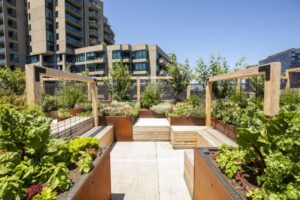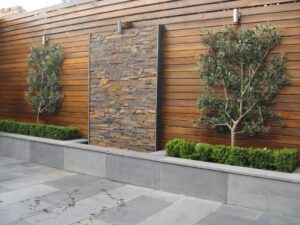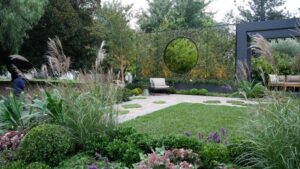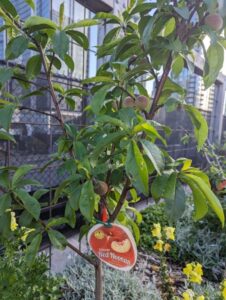
Fruitful design for unusual garden spaces
By Gabrielle Stannus
These days you do not need an entire orchard to grow fruit. This is fortunate as our population is becoming increasingly urbanised and the quarter-acre block is almost a relic of times gone past. We are living on smaller blocks with little or no outdoor space, with potential growing area often restricted to less-than-ideal growing environments, e.g. rooftops, balconies. I spoke with two experts who provide advice on how you can design and construct a fruitful garden for your client in these circumstances.
Rooftops
“Melbourne Skyfarm is probably the jewel in our crown of food-producing landscapes,” says Georgia Warren, Landscape Architect with The Sustainable Landscape Company (TSLC).

Melbourne Skyfarm is a productive garden set on approximately 2,000 m2 of disused rooftop car parking space at the Melbourne Conference and Exhibition Centre (MCEC). TSLC saw an opportunity to convert this vacant space into a community garden and applied for, and received, a grant from the City of Melbourne’s Urban Forest Fund to do so. Set to open to the public this year, Melbourne Skyfarm is already producing a harvest that is currently being donated to Oz Harvest.
The Melbourne Skyfarm rooftop garden is situated in what should be a very challenging growing environment. It essentially sits in an urban canyon surrounded by skyscrapers whose hard surfaces are buffeted by wind. TSLC has sheltered the plantings here using a series of shade cloth panels and dwarf olive trees around the perimeter, allowing other fruit trees, including apples and stone fruit, as well as vegetables and herbs to be grown in the interior. “This has helped the fruit trees on the outside to establish, and then they have in turn provided wind protection to the other plants,” explains Georgia.
To save space and reduce the load on the roof, TSLC have used a variety of dwarfing and compact fruit trees. These plants including a Dwarf Red Noonan peach, pomegranates pruned to size, and multiple citrus including lemons and limes. Public landscapes and private gardens have benefitted from the development by commercial growers of a wide range of modern fruit tree varieties grown on dwarfing rootstock1. These smaller trees can be planted more closely, cropped more heavily, and are easier to harvest from, often without needing a ladder. Alternatively, you could select ballerinas (also known as minarettes); compact fruit trees that consist of a single stem or central leader that fruits on short spurs. These columnar varieties can be used in pots, courtyards, and other small gardens. Popular varieties include the Ballerina® apples ‘Bolero’, ‘Waltz,’ ‘Polka’, and ‘Flamenco’.
To provide a waterproof growing environment on this rooftop, TSLC uses Biofilta’s Foodcubes. “These cubes have approximately thirty-two centimetres of substrate and then a reservoir of water underneath. That works well for citrus because those plants are so shallow-rooting,” Georgia explains of what are essentially raised wicking beds.
Balconies
Growing fruit in containers is essential if you want to establish a successful roof top garden, or in other growing environments without direct access to soil such as balconies.

“One client came to us wanting to create this beautiful, wild productive garden. She had a big property with a lot of productive plants and fruit trees before, and she was moving into this third-story apartment with a balcony in Brunswick. We wanted to give her that productivity while also maximizing the very small space. So, we used the Foodcubes again,” says Georgia. This balcony’s cubes contain dwarf peaches, dwarf mulberry, Trixzie® ‘Nectazee’, Pyrus communis ‘Beurre Bosc’, Pyrus communis ‘Williams’, Trixzie® Black Cheree Miniature Cherry, bay tree, and olives. If designing an edible garden for a balcony or rooftop, you may be able to increase your plant palette by growing fruit in moveable containers. Plants can then be moved to an appropriate place to shelter during winter before being returned to the sun in late spring. Make sure these containers are fully sealed to prevent leakage and that any overflow is diverted safely away from the balcony or rooftop.
Depending on the aspect and direction of prevailing winds, you may need to add some form of protection to shelter plants. Georgia says that TSLC have used a combination of shade cloth and reinforcement mesh (reo) arches to provide protection to plants on this balcony. The reo arch doubles as a growing surface for climbing plants whilst also acting as an sheltering arbour under which the client can entertain. This balcony arch is currently growing Wisteria and beans (legumes are technically fruit!). You could consider using similar structures to grow other types of fruit.
Walls and fences
Remember that the walls and fences in your landscape and garden designs can fulfil more than one function. Whilst they can divide spaces and/or restrict access to a garden area, these structures can also be used to increase the productive growing area of a space through the art of espaliering.
According to Chris England, almost any fruit tree can be espaliered. Together with his wife Jenny, Chris runs Merrywood Plants, a Victorian business specialising in espaliered plants. Their fruit trees have ended up in gardens designed by Paul Bangay and Stephanie Alexander, and featured in an episode of Michael McCoy’s Dream Gardens. Chris and Jenny currently have over 7,000 espaliered plants growing including citrus (lemons, limes, oranges, mandarins, finger limes, yuzu) and deciduous fruit (apples, pears, plums).

Chris and Jenny produce both formal and informal espaliered plants. “Traditional formal espaliers have straight lines, with a central stem and horizontal branches. It is what the English and the French did in the 15th and 16th centuries. Formal espaliers do not have to be horizontal; they can curve. However, they are still essentially straight,” says Chris, “Whereas with an informal espalier, you are trying to fill the whole area (e.g. lattice), to keep it thick and full.”
When growing an informal espalier, Chris looks for plants with lots of bottom branching to ensure that there will be plenty of shoots to cover the whole area. This strategy also means that the fruit stays down low so that it can be netted, and later picked at a reasonable height without using a ladder. Chris says that a formal espalier may take a little longer to create than an informal espalier, sometimes up to several years. However, the impact of these living sculptures is worth the extra wait. Most of Merrywood’s formal espaliers have been trained using a multiple cordon method, i.e. one central main leader (trunk) with three or four horizontal branches. Chris and Jenny include also produce formal espaliers in Candelabra, Serpentine, Belgium Fence and Diamond shapes.
Chris advises realistic spacing of plants along a trellis, especially those plants espaliered more formally. “They will get wider. They all get bigger than just two meters wide. When I visited the potager at Versailles, the espaliered plants were five or six meters wide.” Also, if buying already espaliered trees, you will need to design your trellis to support these plants around the lateral branches that have already been formed, and not the other way around. When planting a pre-grown espalier in situ, install training wires or mesh to follow the branches that are already developed to ensure that the plant continues to take the desired shape.
“The more you look after your espaliers, the better they are going to look, the healthier they are going to be, and the more fruit you are going to get. Summer pruning is critical,” explains Chris, “Horizontal shoots are less apically dominant and tend to produce more fruit and flowers on those shoots. Train those shoots when they are flexible and (your espalier) will produce fruit for you for many years.”

Pathways and borders
Stepovers are another way of incorporating fruit trees into a small space. A stepover is a single cordon (or central leader) that has been bent over at a right angle close to the ground to form a low, horizontal tree which theoretically can be stepped or walked over2. Chris has grown stepovers for landscape designers inspired by French gardens, e.g. the Château de Villandry where apple stepovers provide the ultimate productive perennial borders along the potager’s pathways.
If you want to grow a stepover, make sure you select a very dwarfing rootstock. The Royal Horticultural Society recommends using M27 rootstock for apples, or Quince C or Quince Eline for growing pears3. And remember that you will need a pollinating partner tree unless growing a self-fertile cultivar. If you want a similar effect with perhaps a little less effort than a stepover, consider growing a dwarf blueberry hedge, although remember that this deciduous plant will be bare during winter.
GENERAL TIPS
Select the right plant for your climate

No matter which climate zone of Australia you are in, you can grow fruit. Determine which plants will work for your client by checking the location’s heat and cold zones. What is this location’s absolute minimum temperature and how many days over 30°C does it experience annually? For example, many fruit trees require a minimum number of chill hours annually, e.g. deciduous orchard fruit trees and nut trees, and cannot be grown successfully in tropical environments. They still however require a sunny aspect!
“You need sunny locations for a lot of fruit trees. Do not give them part shade, it just does not work,” says Chris. Georgia agrees, adding that your plant selection will also have to deal with future climate and its extremes. Do your research and carefully consider the potential of all available microclimates on site. Identify any north facing walls and fences against which you could locate small trees, train espaliered plants or locate pots for summer warmth, e.g. dwarf lemons.
Grow what your client wants to eat!
As well as climate and site conditions, you will need to consider your client’s cultural preferences when it comes to fruit. When cosmetics giant L’Oreal wanted a productive garden for employees at their distribution centre, the TSLC design team consulted with staff before preparing the plant palette.
“Our client contact sent out a staff survey and it came back with all the things that the staff wanted. Strawberries ranked super highly as well as nectarines and lemons,” says Georgia. “So, we have provided this space where they can grow veggies and we have planted citrus and stone fruit trees. There is even a pergola so that people can have meetings out there and gather socially if they would like to.”
“If you are proposing or planting fruit trees that people do not eat very often or they are not familiar with, there is just not going to be the same level of buy-in compared to something they really want. It is something that we hear all the time as designers to start from the consultation phase. I really cannot emphasize it enough with plants like fruit trees; they are food. You want people to want to cook and eat with it,” says Georgia.
Partner up for pollination
If you only have room to plant one fruit tree, buy a self-fertile variety that will pollinate itself without needing a partner. Many fruit trees require cross pollination, especially apples, pears, and plums. They will need a pollinating partner or even two to achieve a productive harvest.
Alternatively, to increase the type of fruit you can grow in a small space you could select a multi-grafted tree, which has more than one cultivar grafted onto a single rootstock. Instead of multi-grafted fruit trees, Chris plants two different apple varieties together in one pot and does the same with pears and plums. Planting in this way allows for cross pollination without the worry of the intricacies of pruning the grafts for uniform growth. Chris prefers double planting fruiting varieties as sometimes some grafts can be more dominant and can take over. Double planting can take place in a pot or directly in the soil.
While we are on the topic of partners, remember that some species are dioecious, possessing male and female sex organs on different plants. Therefore, to grow some varieties successfully to bear edible fruit, you will need to select both a ‘male’ and a ‘female’ plant, e.g. Kiwi (Actinidia deliciosa) or the native Mountain Pepper (Tasmannia lanceolata). The latter are normally grown from cuttings to ensure that the sex of the plant is known.
The final word…
To allow your client to grow fruit successfully in the unusual spaces that our modern urban landscapes provide, incorporate dwarfing and compact fruit trees, space-saving tree forms such as espaliers, and fruit in containers, into your designs.
And finally, Happy New Year! I hope that 2024 will be fruitful for you, your business, and your clients. Get out there and get growing!
WHAT IS A FRUIT?
When you think of a fruit, what comes to mind? My well-worn and slightly dog-eared copy of Name that Flower defines a fruit as, “the ripe ovary of a flowering plant, sometimes including accessory structures (e.g., the beak and pappus of a dandelion)”4. However, your clients and customers probably do not think of fruit in this way, instead associating the term with those plant parts that they can eat for their own nourishment or pure pleasure.
Many plants bear fruits safe for human consumption, and not only on trees. Here is a brief list of fruiting plants of different types and sizes to inspire your landscape and garden design thinking5..
Orchard fruits include apples, pears, quinces, plums, apricots, peaches, nectarines, and cherries. Many of these plants are deciduous, so if planted in the right spot can allow sun into the space you are designing during winter and then shade in summer.
Perennial tender fruits include lemons, oranges, olives, kiwi, passionfruit, and the ubiquitous loquat. These evergreen fruits will provide cover throughout the year. Both orchard and perennial fruit trees are also known as ‘top fruit’ given the location of fruit on those plants, i.e. at the top!
Readers in the northern latitudes of this country will be familiar with tropical and subtropical fruits such as pineapple, banana, dates, mango, pawpaw, guava and avocado. Commercial growers are now harvesting avocadoes in Tasmania, as are some home gardeners, if tress are planted in a suitable protected microclimate. You could do the same too but be realistic as to your site’s conditions and do not set your client up for too much maintenance or potential failure.
Let us not forget nuts, although agreeing on a definition of what constitutes a nut is a little more fraught with (professional) danger! Turning back to my trusty copy of Name that Flower, a nut is “a hard, dry, indehiscent, one-seeded fruit derived from a syncarpous ovary”6 . That sentence was a bit of a mouthful, much like an acorn, the example of a nut provided by the authors of that book. Essentially a nut is a dry fruit that consists of a hard shell covering a single seed. In Australia, botanical nuts include exotic chestnuts and hazelnuts, which are grown commercially. Other plants known as nuts, in a culinary but not botanical sense, include almonds, cashews, (native) macadamias, and pistachios (all of which are seeds of drupes), pecans and walnuts (drupaceous nuts), and peanuts (legume). According to Chris England from Merrywood Plants, any nut tree can be espaliered. However, he says it can be hard to keep the fruiting material down low on the plant.
Slightly more exotic fruits include flowering shrubs with fruit such as elderberries, rose hips and hawthorn. Be mindful though of some of these species, which have fruit that birds find very attractive, as they can become invasive especially in and around environmentally sensitive areas.
Ornamental rhubarbs (Gunnera manicata and G. tinctoria) are appealing, but when space is limited, why not plant the edible garden rhubarb (Rheum rhabarbarum) instead? Consider also other soft, bush, and cane fruits such as strawberries, blueberries, raspberries, other berries, currants, or grapes.
Similarly, there are many ornamental pepper varieties available on the market. Do your client a favour, and provide them with space to grow edible peppers instead, and/or other annual tender fruit such as tomato, eggplant, cucumber, watermelon, zucchini, and squash. Your client’s health and their hip pocket may just thank you for it!
Fruitful climbers
The climbing patterns or habits of some fruit varieties can be exploited for both their productive and sheltering characteristics, i.e. growing against a wall or fence, or up an arbour, pergola, or façade. If you want winter sun and summer shade, then select a deciduous climbing plant, e.g. kiwi or grape.
To design or specify a suitable growing structure to accommodate a climbing plant, you need to understand what mechanism that plant uses to climb. Most climbing plants attach themselves to a surface or structure in one of two ways: Self-clinging, or by twining and tendrils7 . Self-clinging plants attach directly to a solid wall or surface via adhesive suckers, disks, or adventitious roots. Twining and tendril climbers attach by twining stems or by hooking and clasping tendrils (modified leaf/stem organs), so they require a specialised support system. Examples are:
- Kiwi (Actinidia deliciosa) – vine climbers that grow around their supports, so select a system with vertical orientation and rungs for support.
- Passionfruit (Passiflora spp.) and grapes (Vitis spp.) – leaf or tendril climbers that require a lattice or grid system comprised of suitably spaced horizontal and vertical wires for support.
- Scrambling climbers such as brambles (Rubus spp.) also require a lattice or grid system for support as these types of plants use thorns, bristles, or side shoots to climb.
According to manufacturers of climbing rope systems, the vigour, size and climbing pattern of the desired climber, as well as the architecture of the structure on which the support will be mounted, and the overall desired aesthetics, will influence the design of suitable supports for climbing. Important considerations to factor into your growing structure design include:
- Ideal height and width of climber supports
- Distances from wall
- Wire rope spacing for vines
- Lattice size
- Wire rope or rod diameters8
Gabrielle Stannus
Inwardout Studio
M: 0400 431 277
E: gabrielle@inwardoutstudio.com
References
- Buckingham, A, 2018, Grow Fruit, Penguin Random House, Melbourne, p.217
- Buckingham, A, 2018, Grow Fruit, Penguin Random House, Melbourne, p.32
- The Royal Horticultural Society 2024, Apples and pears: stepover training and pruning, viewed 8 January 2024, https://www.rhs.org.uk/fruit/apples/stepover-training
- Clarke, I, & Lee, H, 2003, Name that Flower: The identification of flowering plants, Melbourne University Press, Carlton, p.270
- Flowerdew, B, 2018, Bob Flowerdew’s Complete Book of Fruit in Australia, revised edition, Simon & Schuster, Cammeray, New South Wales
- Clarke, I, & Lee, H, 2003, Name that Flower: The identification of flowering plants, Melbourne University Press, Carlton, p.273
- State of Victoria 2014, Growing Green Guide: A guide to green roofs, walls and facades in Melbourne and Victoria, Australia, p.60
- Jakob, A.G, Switzerland 2003, Green Solutions G1, product catalogue, ArchiExpo, October 2003, 1988 / 2003 Rev. 1, viewed 9 January 2024, https://pdf.archiexpo.com/pdf/jakob-france/green-solutions-g1/72278-282138.html
